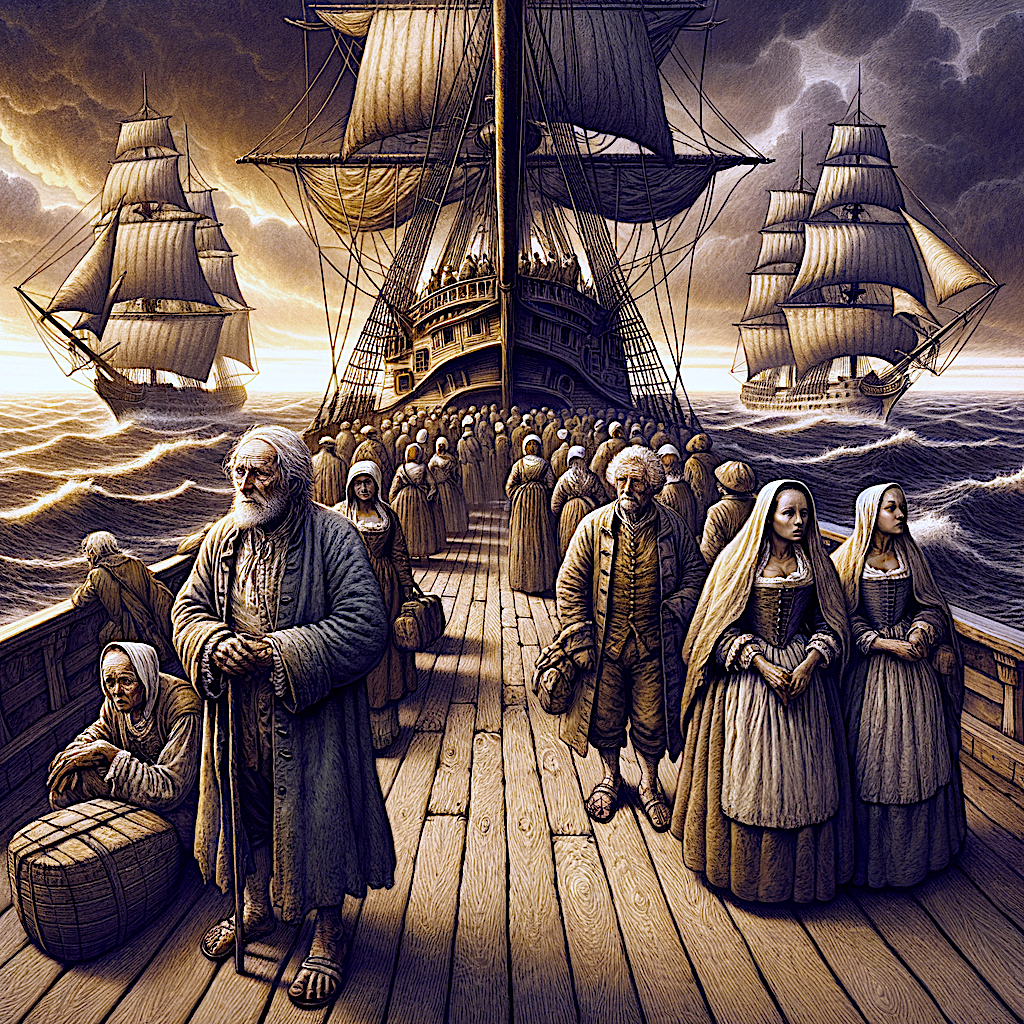Forgotten Voices: Children, War, and the Refugee Crisis History Refuses to Learn From
Claude Edwin Theriault’s “Cajun Dead et le Walkin' Stick” uses artful parallels to link today’s refugee crisis to centuries of human displacement


The Silent Catastrophe: How Today's Humanitarian Crisis Echoes Through History
In a world dominated by fleeting headlines and algorithm-driven news cycles, the global humanitarian crisis is a testament to our collective failure of attention. With over 120 million people forcibly displaced worldwide, we are witnessing the largest human displacement crisis in recorded history. Yet, despite its staggering scale, this catastrophe remains largely invisible in public discourse, relegated to occasional news segments quickly forgotten. Through compelling artistic parallels like Claude Edwin Theriault's "Cajun Dead et le walkin' stick" trilogy, we can understand how today's refugee crisis connects to historical patterns of displacement that have plagued humanity for centuries.

The Invisible Emergency: A Crisis Hidden in Plain Sight
The current humanitarian crisis represents an unprecedented emergency that paradoxically remains unseen. This crisis fails to maintain sustained public attention despite affecting millions across multiple continents, from Syria to Venezuela, Sudan to Ukraine. Statistical evidence paints a grim picture: according to recent UNHCR data, one person is forcibly displaced every two seconds somewhere in the world. The sheer volume of human suffering has created what psychologists term "compassion fatigue"—a numbing effect when tragedies become too overwhelming to process.
This invisibility is not accidental but systemic. Media coverage tends to spike briefly during dramatic events—a capsized boat in the Mediterranean, a bombed shelter in Gaza—before quickly fading as news cycles move on. Meanwhile, political discourse increasingly frames refugees as security threats rather than victims of circumstance, further pushing their humanity from view. International aid organizations report chronic underfunding for humanitarian responses, with appeals regularly receiving less than half the requested amounts, demonstrating how this crisis remains fundamentally unaddressed despite its magnitude.
Children: The Unseen Victims Bearing the Heaviest Burden
Within this global catastrophe, children suffer disproportionately, their voices and needs systematically overlooked. Current statistics reveal that children constitute nearly 40% of the displaced population worldwide, with millions missing educational opportunities and basic healthcare. The psychological trauma inflicted upon young refugees often goes unaddressed, creating a generation marked by unresolved grief and interrupted development.
Children in refugee camps face heightened risks of malnutrition, disease, and exploitation. Education, a fundamental right and crucial protective factor, becomes a luxury many cannot access. UNICEF reports that refugee children are five times more likely to be out of school than their non-refugee peers, creating a devastating gap in development and prospects. Girls face additional threats of early marriage and gender-based violence, while boys risk military recruitment and forced labour. These children, robbed of both childhood and opportunity, represent not only a present humanitarian failure but a future social crisis as their potential remains undeveloped and their traumas unhealed.
The systemic neglect of children's needs in humanitarian responses reflects broader societal failures. Despite international conventions specifically protecting children's rights in conflict situations, implementation remains weak, funding is insufficient, and political will is inconsistent, leaving millions of young lives permanently altered by circumstances beyond their control.
Artistic Resonance: How Theriault's Work Illuminates Historical Patterns
Contemporary French Acadian artist Claude Edwin Theriault has created a powerful lens through which to view today's crisis with his "Cajun Dead et le walkin' stick" book trilogy. This ambitious artistic project draws explicit parallels between the 1755 Acadian expulsion from Grand Pré and contemporary refugee experiences, illustrating how displacement represents a 400,000-year-old byproduct of warfare and conflict. Theriault's work serves as artistic expression and historical documentation, preserving and connecting memories of displacement to present realities.
The trilogy uses the historical trauma of the Acadian expulsion—when British authorities forcibly removed French settlers from present-day Nova Scotia—as a parable for understanding modern forced migration. Just as Acadian families were torn apart and scattered across unfamiliar territories, today's refugees experience similar patterns of family separation, cultural loss, and territorial dispossession. Theriault's artistic vision reveals how these seemingly distant historical events share fundamental similarities with contemporary experiences, suggesting that displacement is not an anomaly but a recurring feature of human conflict.
By portraying war as "the biggest industry in the world," Theriault's work challenges us to recognize how economic and political systems benefit from the conflicts that generate refugee crises. His artistic exploration suggests that humanitarian crises persist not from lack of resources but from deliberate choices about how power and wealth are distributed globally. Through visual storytelling and historical juxtaposition, Theriault creates an accessible entry point for understanding complex humanitarian issues that might otherwise remain abstract and distant.
Breaking the Cycle: Moving Beyond Compassion Fatigue to Action
Addressing today's humanitarian crisis requires moving beyond temporary emotional responses to sustainable engagement and action. This transformation begins with recognizing historical patterns that connect past displacements to present emergencies, creating a framework for understanding and response. By acknowledging the systemic nature of refugee crises throughout human history, we can better identify the structural changes needed to address their root causes.
Effective responses must prioritize children's needs, recognizing them not as passive victims but as individuals with rights and agency. This means ensuring that humanitarian programming incorporates educational opportunities, psychological support, and protection measures for young people. It also requires long-term thinking that addresses not just immediate physical needs but the developmental consequences of displacement on children's life trajectories.

Individual action can make meaningful differences despite the overwhelming scale of the crisis. Supporting organizations with proven track records of effective intervention, advocating for refugee-friendly policies, challenging dehumanizing rhetoric about displaced persons, and creating community welcome initiatives all contribute to a more humane response. Artists like Theriault show how creative expression can bridge historical understanding with present urgency, helping overcome the psychological barriers that keep us from engaging with humanitarian realities.
By connecting historical events like the Acadian expulsion with today's refugee experiences, we gain perspective that transforms abstract statistics into recognizable human patterns. This understanding creates emotional resonance and practical insight, potentially breaking the cycle of attention and neglect that characterizes our collective response to humanitarian crises.
FAQS About the Global Humanitarian Crisis
Why is the current humanitarian crisis considered unprecedented in scale?
Today's humanitarian crisis involves over 120 million forcibly displaced people worldwide—the highest number ever recorded. This includes refugees crossing international borders, internally displaced persons within their countries, and asylum seekers awaiting legal recognition. Multiple major crises occurring simultaneously across different regions have created a perfect storm of displacement, overwhelming traditional humanitarian response systems and creating unprecedented challenges for affected populations and assistance organizations.
How does the current refugee crisis specifically impact children's development?
Children experiencing displacement face disruptions across all developmental domains. Physically, many suffer from malnutrition and preventable diseases due to limited healthcare access. Cognitively, educational interruptions (averaging 3-5 years) create learning gaps that often become permanent. Psychologically, exposure to violence and uncertainty creates trauma responses that can persist into adulthood. Socially, the loss of community and peer connections disrupts normal socialization. These compounding factors create developmental challenges that can affect entire life trajectories when left unaddressed.
What parallels exist between historical displacements like the Acadian expulsion and today's refugee experiences?
Historical displacements like the 1755 Acadian expulsion share striking similarities with contemporary refugee experiences: families forcibly separated, cultural identities threatened, communities dispersed across unfamiliar territories, and bureaucratic systems that dehumanize victims. The loss of homeland, property confiscation, language suppression, and generational trauma appear consistently across displacement events separated by centuries. These parallels reveal displacement as a recurring pattern in human conflict rather than a temporary anomaly, providing valuable context for understanding today's crisis.
Why does public attention to humanitarian crises often fade despite ongoing suffering?
Psychological research identifies several factors contributing to this attention gap: compassion fatigue from prolonged exposure to suffering; the "identifiable victim effect," where individual stories generate more empathy than statistics; media cycles prioritizing novelty over ongoing situations; and psychological defence mechanisms that help distance us from overwhelming tragedy. Additionally, political framing often portrays refugees as security or economic threats rather than humanitarian concerns, shifting focus from human suffering to perceived risks.
What effective actions can individuals take to address the humanitarian crisis beyond donating money?
Individual actions with meaningful impact include: advocating for refugee-friendly policies through contacting elected officials; volunteering with local resettlement organizations; participating in community sponsorship programs; challenging dehumanizing rhetoric about refugees in personal and professional circles; supporting businesses owned by or employing displaced persons; creating welcoming community spaces; learning about the historical contexts of displacement; and using personal platforms to amplify refugee voices rather than speaking for them. These actions address both immediate needs and the systemic issues underlying the crisis.



